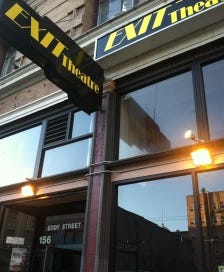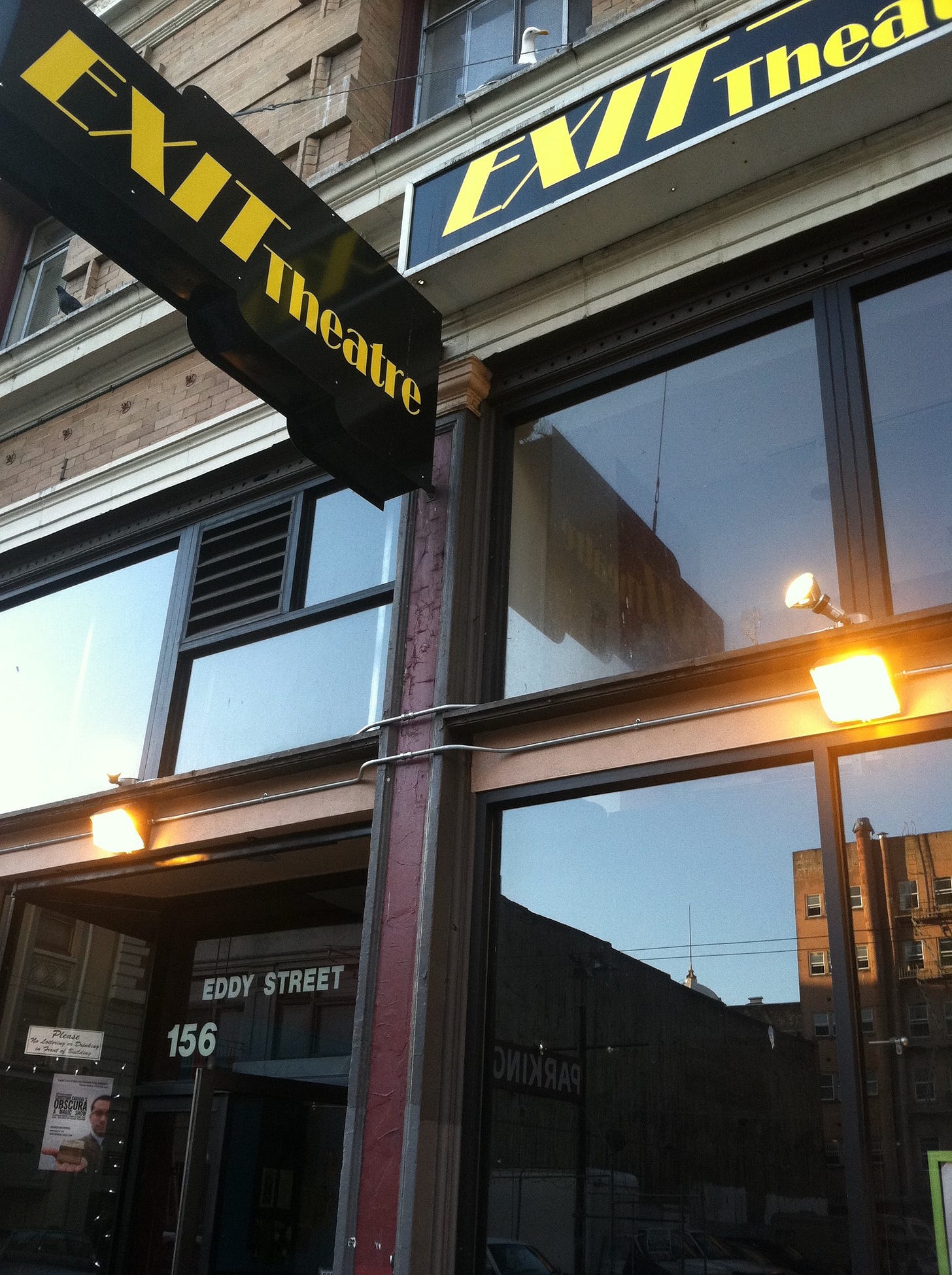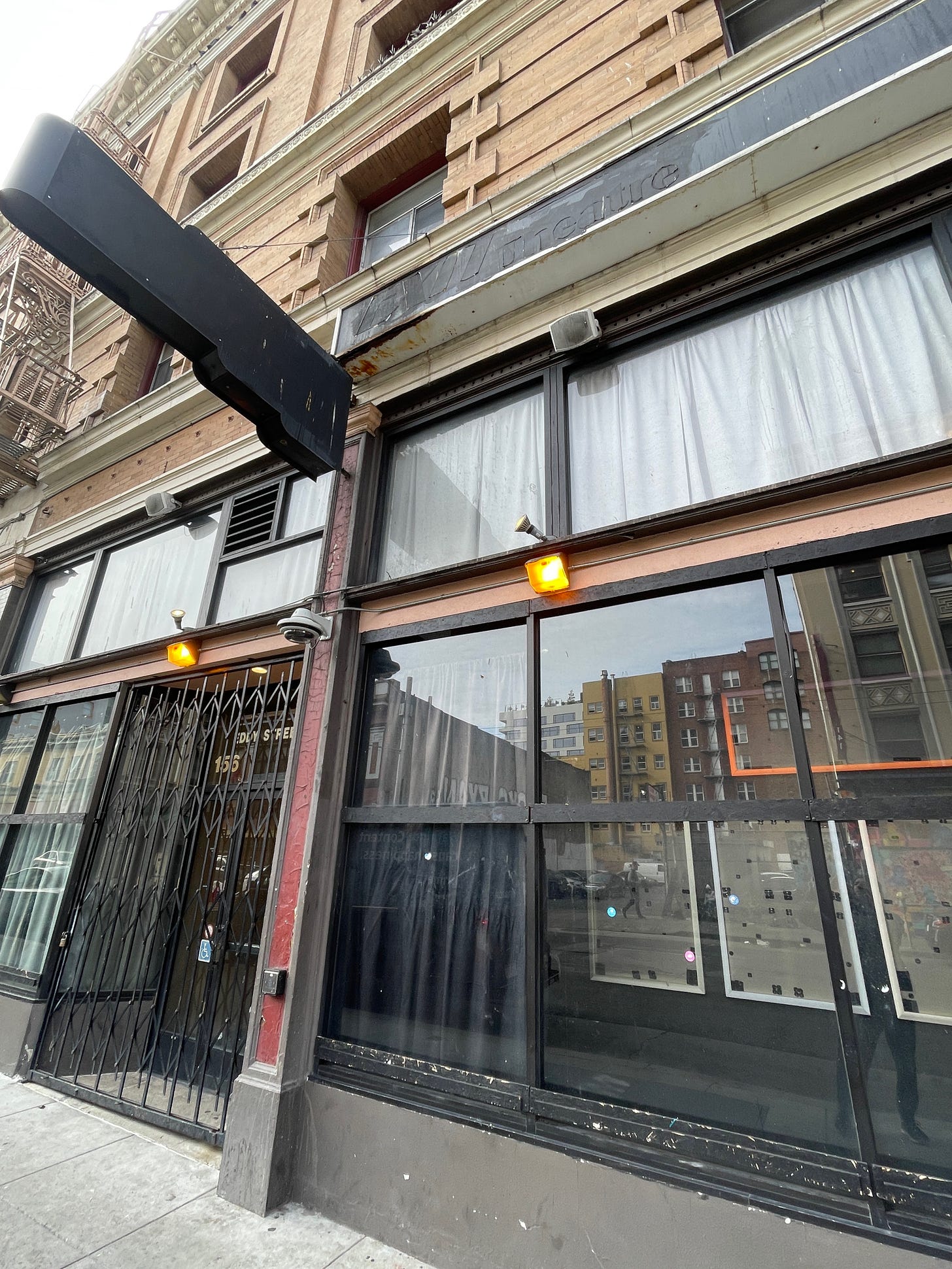EXIT, and The Arts Fixing Downtown San Francisco
Took a walk through the old neighborhood the other day. Stopped by some of my former favorite haunts. It was hard to look at the now empty storefront where the iconic EXIT Theatre resided for almost forty years. Founder/artistic director Christina Augello, and Executive Director Richard Livingston, were two of the first to welcome me to the Tenderloin when I arrived in 2009. Two wonderful people. Two survivors. I would sit upstairs in the cramped control room above one of the black box spaces they built, listening to their fascinating stories of serving the theater community and building out their landmark location, foot by square foot.
The EXIT then.
The EXIT now.
I kept walking. Original Joe’s, a beloved restaurant owned and operated by the wonderful Duggan Family, which also warmly welcomed me to the neighborhood. PianoFight, owned and operated by two creative arts entrepreneurs. The 21 Club, run by Frankie. The 21 Club was a complicated place. Farmerbrown, a place of culinary cultural celebration and refuge. Empty facades all. The arts are a powerful catalyst for the hospitality industry, and the hospitality industry benefits the arts. Or at least once did. I’m happy for CounterPulse. There’s some EXIT Theatre DNA in their new home. That project started when I asked Richard Livingston to evaluate the formerly derelict building’s viability for renovation. I made the arrangements with the property owner at the time, and Richard kindly volunteered his time. He reported back: “Needs work, but has good bones.”
I crossed the street and took the elevator up to Rise Over Run, a beautiful rooftop restaurant atop the LINE Hotel, all conceived and built by the brilliant, design/arts-centric developer Joy Ou. Everybody told Joy she was nuts to want to build a new-construction hotel, while also rebuilding two of the worst blocks in the city. In any city. But she did – picking up a bunch of design awards along the way – and in the face of a pandemic that shook the world. There I joined her, the indomitable Krissy Keefer, Artistic Director and Executive Director of Dance Mission Theater, and my dear friend Darryl Smith, an arts legend in the Tenderloin and street arts community worldwide, and co-founder of the 509 Cultural Center/Luggage Store Gallery.
I listened to their stories. There was a full-on exodus out of Mid-Market/downtown SF: retail, hotels, businesses of all types. It’s all over the news around the country.
And there was talk of the city, once again, turning to the arts to save downtown. I had already heard of rumblings from a friend on the board of CAAM.
The arts. I was invited to San Francisco to help lead community economic development through the arts. The last go around was pre-tech, when Market Street — from 5th to Van Ness — was a ghost town, one dead empty building after another. The city had an amazing roster of highly accomplished arts/arts education organizations looking for a home. Major philanthropy took interest: The SF Foundation, The Rainin Foundation, The William and Flora Hewlett Foundation. When tech came, the city instantly lost all interest and abandoned the arts; it was like flipping a switch. Tech would save us, we were told, though from what I witnessed we mostly got reflective vests for street cleaning and donated laptops for kids.
There was lots of anger and resentment, but I never blamed tech for not saving the city; I didn’t know it was their job in the first place. Now, after the city abandoning the arts, tech was abandoning the city. And the arts, it appears, are back in vogue.
One could be cynical, but maybe it will be different under London Breed, who comes with an arts background and has been, I was told, an arts funding-friendly mayor, particularly arts education.
I hope they’re successful. I’d recommend ensuring there is genuine buy-in across the board. During the last go-around, while then-mayor Ed Lee was making pronouncements about supporting the arts, his director of economic development was undermining his efforts by blocking arts space development policies. While the local supervisor was publicly highlighting her commitment to the arts, her senior staff was deleting, line-by-line, arts incentives in draft economic development legislation. When Carey Perloff raised $30 million to resurrect the long-derelict Strand Theatre on Market Street – a project engineered by the brilliant Ellen Richard – American Conservatory Theatre was rewarded with a bill from the city for “impact fees.” That, plus massive overhead for private security services; money that could have gone toward drama education programs for troubled kids who need to find a different way to experience success.
Krissy is a force of nature. She radiates energy. In all my years working with arts organizations, she is the only person I’ve come across that possesses the skills and talents of both an artistic and executive director. She’s a unicorn. Listening to her list the many demands placed on artists and arts organizations, I summed it up by offering: They want you to fix it. Government will ask you to do it with little resources. Philanthropy will insist you be data-driven, evidence-based, results-oriented. Above all, they’ll insist you be “equity centered,” philanthropy’s new favorite catchphrase.
Our conversation reminded me of what the late Larry Harvey, founder of Burning Man, once told me about using the arts and artists being called on to fix downtown.
All that said, I’m rooting for the city. I still argue, as I did over a decade ago, that we concentrated too much extreme poverty in too small an area. Progressives, who overwhelmingly come from money, and live in nice places with yards and great views, disagree. Study after exhaustive study — all concluding that concentrated poverty is bad news for poor people — be damned. Ideologues don’t care. Low-income families, who overwhelmingly come from little or nothing, and who live at 201 Turk Street, wholeheartedly agree. Each day they live what the public health studies conclude.
I hope this time the arts get treated fairly, honestly, and with sufficient, “equitable” resources. That would go a long way toward resurrecting San Francisco’s downtown. Maybe there’s still a chance. Hopefully we won’t make the same mistake again, this time with the growing frenzy about the imminent AI gold rush. Our next flash in the pan money; looking for our next fast hit to get high again after coming down hard. Pales in comparison to the long-term dividend payoff that investing in human and community capital through the arts provide.
I still place my bets on Krissy Keefer.
Joy, Darryl & Krissy. Three creative giants, sitting in an alcove in the hotel Joy built, LINE SF. Many of the common spaces and rooms feature work by local artists, a collaboration between Joy and Darryl. Behind them is the wonderful mural Joy & Darryl also collaborated on, painted by the wonderful artist Clare Rojas. The mural was made possible by the Creative Work Fund and arts advocate, author and friend, Frances Phillips.






